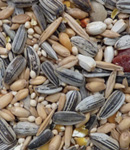Hand raised Quaker parrot information
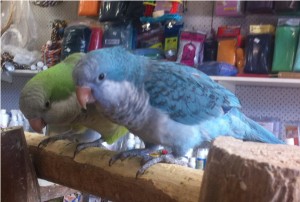
A Quaker parrot (also known as a Monk Parakeet) is a playful and inquisitive bird that can make a wonderful pet. With proper care, they can be quite friendly and develop strong bonds with their owners. Here are some tips for taking care of your hand-raised Quaker parrot:
• Provide plenty of mental stimulation – Qarrot
Quaker Availability at birdsville
Quakers are seasonal breeders which means they only breed once a year and often are ready around January. If you would like a tame hand raised quaker for a pet contact birdsville to lock in one of our babies when they are ready.
The Quaker parrot, also known as the Monk or Grey-Breasted Parakeet, originated from southeastern Brazil through Uruguay to northeastern Argentina.
Quakers are small, only reaching 28 to 30 cm long, with a wingspan of about 48cm and a weight of 90 to 150 grams. The natural color of the Quaker is green, with pale grey on the forehead, cheeks, throat and chest. There are several color mutations of the Quaker, although many color varieties are not yet commonly available. The blue mutation has become very popular within
Australia and many blue Quakers are now being kept as treasured companions.
Quakers can live to be 25 to 30 years of age and perhaps even longer, with a healthy diet they are very hardy birds.
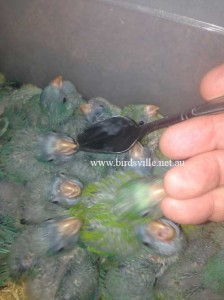
Nature of the Quaker Parrot
The Quaker Parrots are very smart, inquisitive, fun loving and energetic creature. They love to play with their toys, swings and bells. They can entertain themselves for hours practicing their chirps, whistles and human vocalizations.
Both male and female Quakers have an amazing capacity to imitate both sounds and human speech. Most Quakers start talking at 8 months or so, although many start even earlier than that.
Quakers need to be well socialized with the whole family to avoid them becoming a one.
person bird.
I have a Quaker Parrot myself called Beeb who has taken over the house he is very agile in flight and makes sure he is in every room where there are people. His favorite spot is to simply sit on your shoulder. I often bring Beeb into work with me so many of our customers may have met him.
Cage’s for Quacker Parrots
When selecting a cage, it is important to select the largest cage you can afford, there is a wide variety of cages available at birdsville, remember the bigger the cage the happier the
bird. Quaker Parrots are very active, playful birds and require room for many toys, perches, food/water dishes, as well as sufficient space for them to move around.
It is a good idea to have a cage that is lockable; Quakers can be are little escape artists and figured out how to open their cage doors. Toys are very important item in a Quaker’s cage. Most birds enjoy toys, but with Quakers this seems to be especially true. If toys are not provided for entertainment, a Quaker may find less than desirable ways to relieve boredom such as screaming or feather plucking. Keep three to four toys in the cage at a time. Rotating the toys on a regular basis with others you have on hand will keep your Quaker happy and entertained.
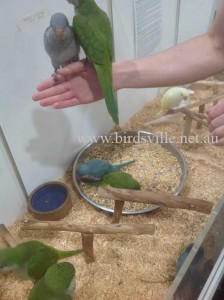
It is very important to give your Quaker toys from a young age as this will actually make your bird much easier to train and your bird will be happy if you exercise the brain from a young age. When birds are young the brain is still developing which is why it is so important to supply lots of toys for these naturally curious birds. A cage should have 3 or 4 toys a ladder and a swing.
Diet for Quaker parrot’s
There are many different perceptions concerning the best diet for Quaker Parrots, but most would agree that a seed-only diet does not provide complete nutrition for birds. A combination of pellets, seeds, fruit and veggies is recommended.
When Purchasing a Quacker that has been weaned, for the first 4 weeks give them an all you can eat buffet of seed and pellets with some fruit and vegetable every couple of days, baby Quakers in new homes may not eat for the first day as it can be scary for a young bird in a strange place. During this time of adjustment place food on the ground as well as in the feeders. For a super tame baby i used hand rearing formula to train my Quakers to come to me as they love the taste and is a very good training tool but only feed them this at the end of the day for weaned birds. My Quaker is 5 years old and still free flies to me if he can see me feeding baby birds. After 4 weeks of having your bird home worm your bird. and after that do not feed them any more food till your Quaker has finished the pellets this way your bird will eat everything, and your bird will be much healthier and robust for it. From my experienced your bird will be in great health and vigor with a varied diet but not an all you can eat diet as they will simply eat the unhealthiest foods first just like kids make sure they finish the plate.
Pellets– are developed to meet the nutritional needs of birds, so they should be a part of a
bird’s diet whenever possible. At Birdsville we recommended the Murphy’s Pellets, Vetafarm Maintenance pellets, Vetafarm parrot essentials pellets or Peckish, Maintenance Pellets feed with seed. You can mix with seed but its more efficient to feed in a seperate dish.
Seed- is still very important for birds as it encourages the natural foraging behavior, with the cracking of the seed. The best seed for your Quaker parrot is a good quality mix of either Cockatiel mix, Peachface Mix or Small Parrot. Be wary of some supermarket brands which have a low-grade seed mix. Birdsville recommended a small parrot mix for younger birds and Peachface or Cockatiel mix for older birds.
Soaked seed– Use cocky mix for soaked seed, Quakers love soaked seed. to learn how to soak seeds click here!
Vitamin supplements– An important addition to maintaining your bird to have optimum health this is added via the water supply. If your Quaker is on pellet’s these will already contain vitamins and there is no need to add more. . Links to popular vitamins are linked – ornithon – vetafarm breeding aid plus – multi vitamins, passwell multi vite your Local Bird specialist bricks and mortar store should stock all of these products.
Greens– spinach, carrot tops, broccoli leaves, endive, fresh grass.
Vegetables– sweet potato, squash, carrot, zucchini, corn, peas etc.
Fruits– Apple, banana, pear, rock melon, stone fruit, kiwi, pineapple, mango, orange, Apples, rock melon, banana, pear, peaches, kiwi to name a fruit to not be alarmed if your cockatiel does not eat fruit as they do not naturally eat much if any fruit in the Australian bush as they mainly feed on seed and greens along as they receive some greens and vegetables your bird will be happier for it.
Do not feed your bird (or any other bird) avocado, onion, chocolate, caffeine or alcohol.
Calcium and vitamin D – Calcium perch which also contains iodine and cuttlebone can also be used. Be careful with indoor birds that do not receive any Natural sun light as this is how birds and we get vitamin D. Many people believe that their Quaker will be ok as it gets sun through a window, sadly vitamin D is filtered out when the suns ray goes through glass. If you, you are unable to provide your bird with natural light add some calcium to your bird’s water supply with liquid calcium and vitamin D.
Worming– have you wormed your Cockatiel?
Very simple birds should be eating food for at least 4 weeks before worming, use a good quality bird wormer which will do all 5 groups of worms. All bottles will have directions to use which is very simple as it is simply placed in your birds drinking water, the day before you worm your bird take the water out in the afternoon, so your bird is thirsty the next 24 hours that the worming solution is placed in the bird water supply.
Adult Quaker parrots should be wormed every 3 months. Baby recently weaned Cockatiel will need to be wormed in two or 3 weeks after being taken home check with the staff from Birdsville, when purchasing). Young birds that have been recently weaned have a delicate bacteria’s developing in their gut, worming at this stage could harm the bacteria’s development and your new bird. Worming will need to be done.
every 6 months. Worming your bird is essential for the health of all parrots in captivity.
Lists of wormers available at Birdsville if you’re unsure of what one to use, or you’re after a vet grade wormer which is what the vets use, ask one of our team members when you are in store, and they can help you. As a major distributor of avian products in Australia our prices are one of the cheapest in Australia. aristopet worming syrup with praziquantel – vetafarm wormout gel – avtrol plus bird wormer
Worming your bird is actually very easy it will simply go in the water supply for amounts simply check the label on the bottle, or on some bottles peel back the label.
Why are worms bad for your bird and you?
Worms cause a range of diseases, the severity of which depends on the species of worm they are infected with. Parasitic worms have an indirect lifecycle with many insects such as fly’s, beetles, other insects and feces acting as intermediate hosts.
Worms can weaken your bird’s immune system which inadvertently can kill your bird from a virus that a bird with a strong immune system can fight off.
if your bird is not wormed regularly and after some time you do worm your bird, the dead worms can cause intestinal or respiratory blockages, in sick adult birds it may be a good idea to worm them with a half dose first. This is at Birdsville we recommend worming every 3 months at least.
Below is a common and wide variety of worms of worms including Tapeworm Worm (Choanotaena spp, Raillietina spp), Thread Worm (Capillaria spp.) Roundworm (Ascaridia spp.), Ceacal Worm (Heterakis gallinarum), Hook Worm Acuaria spp.) in both Aviary and caged Cockatiels.
Mite and lice spray– Lice and mites is as common with birds as fleas are with dogs, there are many varieties of lice, these cannot live on humans but will cause discomfort and if left unchecked can cause your bird problems. Spray your bird with mite and lice all over under the wings around the rear just avoid the eyes and mouth.
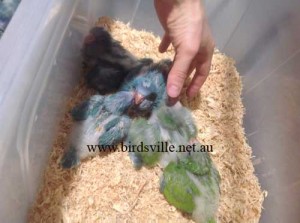
Training Quaker Parrots click here.
Introducing your new Quaker bird to existing birds
Once you take your bird home you should keep it in a separate cage and allow the bird to adjust accordingly. Always allow at least 2 weeks before introducing the bird to an existing bird.
It is risky mixing different species with Quakers parrots, and it’s not recommended to mix any parrot with a much larger parrot as the smaller bird could easily be harmed or killed. Keeping Quakers with similar sized birds is recommended if this is what you choose to do. I’ve seen Sun Conures and Quakers live together very well but remember not all birds are the same and will not always get along just like people.
On that note my Quaker Parrot lives in the same cage as my Sun conure.
More information can be found in store 445 Gardeners Rd Rosebery or call Birdsville (02) 9667 2555.


